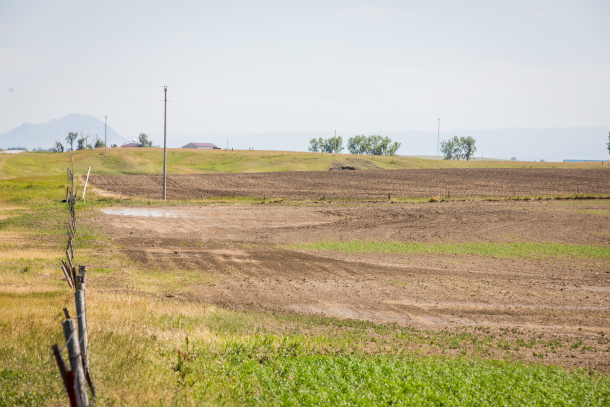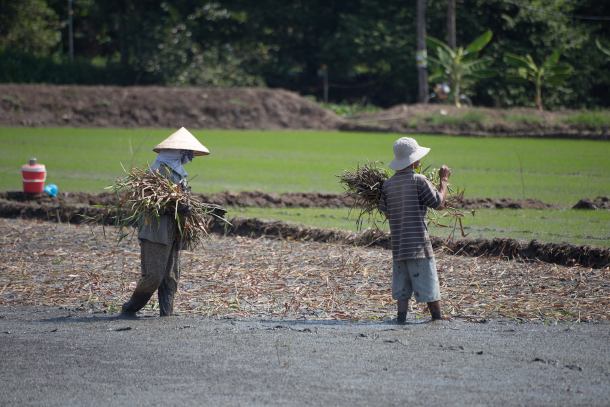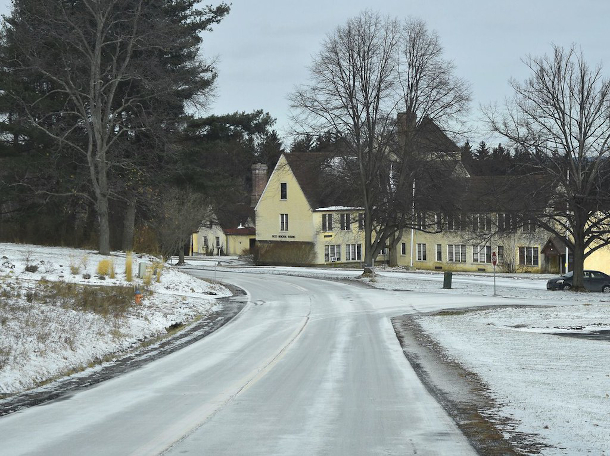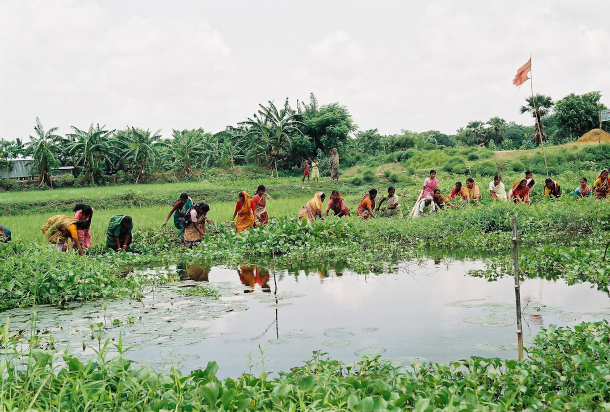Saltier Soils in a Warming World
Air Date: Week of July 1, 2022

A white, barren patch of agricultural land is visible where salt has become concentrated in a field. (Photo: USDA NRCS South Dakota, Flickr, CC BY-SA 2.0)
Rising seas and temperatures are exacerbating the perennial problem of increasing salinity on both coastal and inland farmland. Journalist Fred Pearce joins Host Bobby Bascomb to discuss how this is affecting farmers from Vietnam to Bangladesh and talk about potential solutions.
Transcript
BASCOMB: As we’ve been discussing, the Mekong River is vulnerable to damage from development and large-scale infrastructure projects. It’s also in the crosshairs of one of the dangers from the climate crisis. Parts of the river are becoming saltier because of saltwater intrusion from rising seas. The Mekong River Delta in southern Vietnam is a fertile rice-producing region and home to more than 20 million people, but salty ocean water is pushing into the delta and threatening livelihoods. Just this spring, during the dry season, the salinity boundary reached 40 miles upstream, more than 10 miles farther than it has historically. Freelance journalist Fred Pearce wrote about rising salinity in the Mekong Delta and around the world for Yale Environment 360 and joins me now from London. Welcome back to Living on Earth, Fred!
PEARCE: Thank you.
BASCOMB: So what's happening in the Mekong Delta? Why is there rising salinity there?
PEARCE: There are two reasons. Mekong has got the worst of both worlds. It's got big dams being built upstream, particularly in China, and they're stopping the flood flows of fresh water coming down the river. So fresh water is not getting into the river delta. Added to that, it's got sea level rise coming in from the ocean. So the power of the sea to invade the river delta is increasing. So, with less freshwater coming down and more saltwater coming in, the delta region is getting more salty; there's a kind of barrier of salt which is pushing in. And that's having a really damaging effect on farmers, for people trying to drink the water as well, but principally for farmers and rice farmers. This is one of the world's great areas for rice growing, and it is under threat. We often think about sea level rise and sea invasions as being about water inundating areas, flooding the coastal regions. But in fact, in many regions, much before that happens, the saltwater gets in there, the salt invasion is poisoning crops, poisoning water supplies, and in many cases, people are already having to leave these regions. They may be not flooded, but they're unlivable.

Rice farmers in Vietnam’s Mekong River Delta, which is becoming saltier and less fertile as sea levels rise and upstream dams block freshwater flows (Photo: Alex Berger, Flickr, CC BY-NC 2.0)
BASCOMB: And I would imagine that the Mekong River Delta is not the only delta in the world where this is a problem.
PEARCE: Absolutely not. It's a universal feature. Most of our world's rivers now have dams on them and that means that flows down them are reduced, particularly the flood flows that are most important for keeping their delta regions fresh rather than salty. And of course, sea level is rising. So we can see, for instance, in Bangladesh in the river Ganges and Brahmaputra Delta, a huge delta region there: salt is forcing farmers out even before the rising tide. The same on the Indus River Delta region in Pakistan. And these are the ones that we talk about most, because they're the most densely populated river deltas, but it's a global phenomenon. It's happening everywhere.
BASCOMB: And from what I understand, it's not just happening along the coasts, we're also looking at inland soils that are becoming saltier. Can you explain that for us, please?
PEARCE: That's right. Really, the whole world is becoming saltier. There's a kind of salt invasion going on globally. And it's not all to do with climate change. So for instance, in North America and in Europe, we put a lot of salt onto our roads in the winter in order to stop them freezing over, and a lot of that salt gets into rivers. So we find that river ecosystems, freshwater ecosystems far from the ocean are turning more saline after that happens. We see mining often pumps salty water from underground and pours it in eventually into rivers, so we're seeing salinization as a result of that. And also irrigation projects for farming are a major cause of salination. In an irrigation system, where a large amount of water is put on to the land to be taken up by the crops, the salt gets left behind in the soils. And we see in many parts of the world a buildup of salt. So we're seeing all these effects, and climate change is going to make them worse. We've talked about the saline intrusion as people talk about it, the salt coming in from the oceans as sea level rise. But if you think about how climate change affects inland regions, especially dry regions, as it gets warmer, evaporation rates go up really quite staggeringly fast. So the water is evaporating, again, leaving behind salt in the land. So many parts, arid parts, of the world are suffering already from this. And as temperatures rise and evaporation rates rise, more and more salt is going to accumulate in fields, but also in underground water reserves. It’s a kind of hidden crisis. I don't think we've really got to grips with it yet.

White salt deposits on the surface of the soil in a field where tomatoes are grown in Tunisia. (Photo: Jean-Yves Jamin, Water Alternatives Photos, Flickr, CC BY-NC 2.0)
BASCOMB: You know, I think this notion that irrigation can contribute to salt on the land seems, you know, kind of counterintuitive to a lot of people. Can you talk a little bit more about that? Why would watering crops with freshwater add salt to the soils?
PEARCE: Well, because no water is entirely fresh; all water flowing over the land, eroding the mountainsides as it goes, coming out of whether it's the Andes or the Himalayas or wherever the rivers rise, it will erode and capture a certain amount of salt. And it brings that downstream, and it brings it into irrigation systems, in through the irrigation canals until the water is poured onto the soil so that crops like cotton or corn can grow. Now the crops are damaged by salt, and they pick up some salt but they leave most of the salt behind in the soils. They want the water, not the salt. So the water is coming off the land, but the salt is being left behind. So what started as a very small and perfectly reasonable amount of salt gradually builds up. And there are irrigation projects around the world, which are now pretty much unusable because salt builds up to the extent that they look white, I mean, they almost look like snow because there's an accumulation of salt crystals on the surface of the soil. And at that point, the soil becomes infertile and the crops can't grow. In the parts of Central Asia, we know about the Aral Sea that's been drying up, the Aral Sea was once one of the world's biggest inland seas, has dried up because most of the water has been taken out of the rivers that feed it to irrigate crops, especially cotton. But we're now finding that those cotton fields are accumulating so much salt, and it just stays there. And the only way of getting rid of it is to push more water, flush more water through the soils, and try and sort of gather up the salt and take it out. But with water in short supply, that is an increasingly difficult thing to do.

In winter, road salt helps keep ice at bay but it also washes out into the surrounding soils, streams and rivers, creating ecological and agricultural havoc. (Photo: Jo Zimny, Flickr, CC BY-NC-ND 2.0)
BASCOMB: Fred, what about the role of fertilizer? I believe a lot of fertilizers tend to have salt in them as well.
PEARCE: Yes, salt is an ingredient in fertilizer and the more fertilizer we put on the land, the more salt we put on the land. A bit like putting more water on the land, we get more salt on the land. That has a long-term devastating consequence on the quality of the soils and their ability to grow crops.
BASCOMB: You write in your article that salts intrusion in Bangladesh has already reduced rice production by about 30% in the last 15 years or so. I mean, that's really significant.
PEARCE: Exactly right. At that point, farmers start thinking, Well, can we carry on? Or do we have to move? Now in Bangladesh, they've been quite creative, really. In many regions, they've stopped growing rice in their paddy fields and they're converting their paddy fields to raising prawns. So they're doing aquaculture in what used to be agricultural land. Well, that's one way forward. Aquaculture, if you're bringing more salty water onto the land, your neighbors won't like it, because you're adding to the salt on the environment and all the other rice farmers have to give it up as well. But that's one response. And it happens in the Mekong, and in Bangladesh, we see that. But beyond a certain point, farmers simply give up. So we're seeing salt as a cause of environmental refugees and environmental migration.

Women farmers in Bangladesh, where sea level rise is pushing farmers out. (Photo: WorldFish, Flickr, CC BY-NC-ND 2.0)
BASCOMB: So you have the present threat of food insecurity in a lot of the world. But what about the local area itself and rising salinity? How does that affect the health of the people that are living in the area?
PEARCE: We're beginning to see health effects from the buildup of salt in the water that people drink. So if you're drinking large amounts of salt from the water, I mean beyond a certain point, it's salty, it'd be impossible to drink, but a lot of water is just kind of borderline salty. And people are accumulating sodium and other ions that are in the salt. And these have an effect on hypertension, they can raise your blood pressure levels. There's been some studies in Bangladesh suggesting that maybe 10,000 people a year are dying of these effects directly, from having to drink salty water. Salt can sometimes make water more liable, as it runs through the pipes towards our homes, to dissolve lead from lead piping. In parts of the world where there's lead piping, that's a considerable threat. We had the crisis in Flint in Michigan a few years ago because they started taking water from a river source and putting it through lead pipes without realizing that the water would pick up the lead and deliver it to the citizens, and lead is a nasty poison. But one of the reasons, the chemical reasons, why the river water was accumulating, it was picking up that lead, was because it was quite salty water. So it wasn't the only reason why there was a problem there. But it was a contributory factor.
BASCOMB: Well, this is a multi-pronged issue here, you know, we're looking at health problems, mass migration, collapse of ecosystems, potentially; what can be done about this problem of rising salinity in the soils now that we know so much about it?

Journalist Fred Pearce on the Mekong Delta (Photo: Courtesy of Fred Pearce)
PEARCE: The big thing we have to do, as with many of these things is to stop climate change, because climate change has become the long-term driver of this. And unless we can stop that, things will probably in most places carry on getting worse. But there are many things that we can start to do to reduce the other causes of salination. So we need to think very carefully about how we run our irrigation systems, to make them more efficient so less water has to go on to the fields. And that means less salt is brought onto the fields. And we have to think about drainage systems in irrigation networks so that the salt can be drawn out again. Now it will go into rivers, and it'll have ecological consequences. But if we want to preserve the food supplies, we need to do that. We need to think about how we operate our dams. So we need to think about operating dams so that they provide enough water downstream at the right times of year to allow what is often the sort of flood pulse of during the wet season. So that if there's salt buildup in the delta, it can flush that out. We need to think, in North America and Europe and other places where this happens, we need to think about pouring salt in the way that we now do in a rather reckless manner onto our roads and not really caring that much of it drains away into rivers. We're going to have to think about putting less salt on, perhaps using alternatives to salt. And if we do put salt on, we're going to have to think about capturing that in drains, so that it doesn't go back into the rivers. I think once we start thinking about salt as an issue, we will find solutions. And they're not just about climate change, but if you like, climate change is the one which is going to affect most people over the long term. So we have to fix that. But I think we can do a lot of other things first.
BASCOMB: Fred Pearce is a freelance author and journalist based in the UK. Fred, thank you so much for your time today.
PEARCE: Thank you.
Links
Fred Pearce for Yale e360 | “Salt Scourge: The Dual Threat of Warming and Rising Salinity”
Living on Earth wants to hear from you!
Living on Earth
62 Calef Highway, Suite 212
Lee, NH 03861
Telephone: 617-287-4121
E-mail: comments@loe.org
Newsletter [Click here]
Donate to Living on Earth!
Living on Earth is an independent media program and relies entirely on contributions from listeners and institutions supporting public service. Please donate now to preserve an independent environmental voice.
NewsletterLiving on Earth offers a weekly delivery of the show's rundown to your mailbox. Sign up for our newsletter today!
 Sailors For The Sea: Be the change you want to sea.
Sailors For The Sea: Be the change you want to sea.
 The Grantham Foundation for the Protection of the Environment: Committed to protecting and improving the health of the global environment.
The Grantham Foundation for the Protection of the Environment: Committed to protecting and improving the health of the global environment.
 Contribute to Living on Earth and receive, as our gift to you, an archival print of one of Mark Seth Lender's extraordinary wildlife photographs. Follow the link to see Mark's current collection of photographs.
Contribute to Living on Earth and receive, as our gift to you, an archival print of one of Mark Seth Lender's extraordinary wildlife photographs. Follow the link to see Mark's current collection of photographs.
 Buy a signed copy of Mark Seth Lender's book Smeagull the Seagull & support Living on Earth
Buy a signed copy of Mark Seth Lender's book Smeagull the Seagull & support Living on Earth

